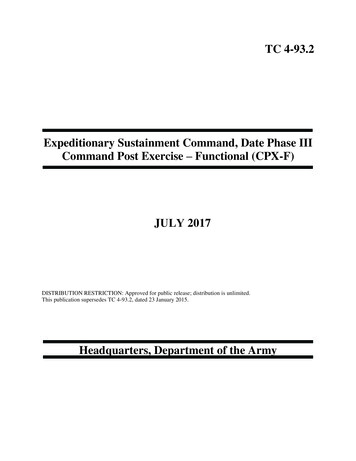
Transcription
TC 4-93.2Expeditionary Sustainment Command, Date Phase IIICommand Post Exercise – Functional (CPX-F)JULY 2017DISTRIBUTION RESTRICTION: Approved for public release; distribution is unlimited.This publication supersedes TC 4-93.2, dated 23 January 2015.Headquarters, Department of the Army
This publication is available at the Army PublishingDirectorate site (https://armypubs.army.mil),and the Central Army Registry d)
TC 4-93.2Training CircularNo. 4-93.2HeadquartersDepartment of the ArmyWashington, D.C.,10 July 2017Expeditionary Sustainment Command, Date Phase IIICommand Post Exercise - FunctionalContentsPagePreface . iiiIntroduction . ivChapter 1Event Overview . 1-11-1. Event Description . 1-11-2. Event Difficulty . 1-21-3. Training Objectives . 1-31-4. Warfighter Training Support Package (WTSP) . 1-51-5. Collective Tasks Trained . 1-51-6. Event Life Cycle (ELC). 1-61-7. Concept Development Workshop (CDW). 1-71-8. In-Progress Reviews (IPRs) . 1-71-9. Final Planning Workshop (FPW) . 1-71-10. ELC Development Recommendations . 1-81-11. Recommended Pre-Execution Training . 1-91-12. STARTEX Conditions. 1-91-13. Battle Rhythm . 1-91-14. Boards, Bureaus, Centers, Cells and Working Groups (BC2WG) . 1-10Chapter 2Event Control . 2-12-1. Exercise Control . 2-12-2. Key Personnel and Responsibilities . 2-22-3. Event Execution Timelines. 2-62-4. Event Synchronization. 2-62-5. Exercise Support Manning Document (ESMD) . 2-72-6. Event Support Personnel Guidelines . 2-72-7. Joint Master Scenario Events List (JTIMS JMSEL) . 2-72-8. Master Scenario Events List (MSEL). 2-72-9. Joint Deployment Logistics Model (JDLM) and Simulation Stimulation(SimStim) Components. 2-8Distribution Restriction: Approved for public release; distribution is unlimited.This publication supersedes TC 4-93.2, dated 23 January 2015.i
2-10. Pre-Exercise Training . 2-82-11. Strategic Partners . 2-92-12. Accessing and Downloading the WTSP. 2-9Chapter 3Communications and Simulations Architecture . 3-13-1. Chapter Overview . 3-13-2. Communications Plan . 3-13-3. Communications Equipment Requirements . 3-13-4. Technical Integration Working Group (TIWG) . 3-23-5. Simulation and Stimulation Plan . 3-23-6. Stimulation . 3-23-7. Joint Master Scenario Events List . 3-3Chapter 4Observation and Assessment . 4-14-1. Purpose of Assessment . 4-14-2. Evaluation vs. Assessment. . 4-14-3. Purpose of O/T Team . 4-14-4. Collection Planning . 4-14-5. Facilitated After Action Review (FAAR) . 4-2Glossary . Glossary-1References . References-1Figures:Figure 1-1. Command Post Exercise Construct . 1-2Figure 1-2. CPX-F’s Relationship to Combined Arms Training Strategy Events . 1-3Figure 1-3. Event Life Cycle . 1-6Figure 1-4. CPX-F Exercise Calendar (Piano Chart) . 1-8Figure 2-1. Exercise Control Group. 2-2Figure 2-2. Exercise Control Diagram (Sustainment Brigade) . 2-3Figure 2-3. Exercise Wrap-Around. 2-6Figure 2-4. WTSP Folder with Associated Annexes . 2-10Figure 3-1. CPX-F Equipment Count EXAMPLE . 3-2iiTC 4-93.210 July 2017
PrefaceThis Training Circular (TC) provides a methodology for planning, executing, and assessing asustainment brigade or expeditionary sustainment command functional training exercise. Itprovides detailed information on the exercise construct and provides guidance on roles,responsibilities, and resourcing. It is intended to fulfill the requirement for a total Army,comprehensive, multi-component training strategy for sustainment brigades and expeditionarysustainment commands. The intent of the Command Post Exercise-Functional (CPX-F) is toprovide a venue for commanders to ramp up (crawl/walk) to a culminating training event.This TC provides guidance for commanders, staff, Training Readiness Authorities (TRA), MissionSupport Elements (MSE) and Mission Training Complex action officers who plan, prepare,execute, and assess the training of Sustainment Brigades (SB).The primary target of this TC is the TRA, MSE and MTC. Elements of the training supportpackage are provided in support of the brigade commander, staff, and other leaders within theSustainment Brigade.This publication applies to the Active Army, Army National Guard (ARNG)/Army National Guardof the United States (ARNGUS), and the United States Army Reserve (USAR) unless otherwisestated.The proponent for this publication is the U.S. Army Training and Doctrine Command (TRADOC).The preparing agency is the U.S. Army Combined Arms Support Command (USACASCOM)Sustainment Center of Excellence (SCoE). Send comments and recommendations by any means,U.S. mail, e-mail, fax, or telephone, using the format of DA Form 2028 (Recommended Changesto Publications and Blank Forms). Point of contact information is as follows.E-mail:Phone:Web:U.S. il.milCOM 804-765-2229 or DSN 539-2229www.cascom.army.milCommanding General, SCoEG3 Training and DoctrineCollective Training DivisionATTN: ATCL-TS-CTDFort Lee, VA 23801Unless this publication states otherwise, masculine nouns and pronouns may refer to either menor women.10 July 2017TC 4-93.2iii
IntroductionExpeditionary Sustainment Command (ESC)MissionThe ESC provides mission command for attached units in an area of operation (AO). The ESCprovides operational reach and span of control. The ESC plans and executes sustainment,distribution, theater opening, and reception, staging, and onward movement for Army forces.The ESC may serve as the basis for an expeditionary joint sustainment command when directedby the combatant commander or his designated coalition/ joint task force (JTF) commander.When the ESC serves as an expeditionary joint sustainment command, the headquarters shouldbe augmented by personnel and equipment from other Services.RoleThe role of the ESC is to deploy to an AO/JOA (Joint Operations Area) and provide missioncommand capabilities when multiple sustainment brigades are employed or when the TheaterSustainment Command (TSC) determines that a forward command is required. The ESC may beemployed directly under the mission command of the corps, Army Forces (ARFOR), or JTF asdesignated by an appropriate order. The TSC maintains oversight of sustainment operationswithin the AO/JOA with direct coordination with the ESC and its sustainment informationsystems. This capability provides the TSC commander with the regional focus necessary toprovide effective operational-level support to Army or JTF missions. The TSC may employmultiple ESCs within the theater.The forward deployment of the ESC facilitates agile and responsive support by placing the ESCin relative proximity of the supported force and its operational environment. Positioned toprovide a regional focus, the ESC is optimally placed to refine that portion of the TSC logisticspreparation of the theater assessment applicable to the JTF area of operations and to arraylogistics forces accordingly. Depending on the command structure within the theater, ESCs maybe employed to support specific Army forces within a specific AO/JOA; or to support otherESCs or sustainment brigades with theater opening or theater distribution capabilities.The ESC role in supporting a JTF is less about supply and more about physical distribution andreadiness. Its purpose is to build and sustain JTF combat power through agile and responsiveJOA-wide support. It achieves its purpose through the effective synchronization and executionof TSC plans and directives in support of JTF operational requirements; executing distributionmanagement responsibilities for its specified AO/JOA; establishing a command climate whereclose coordination and collaboration with the JTF enables decisive action when unanticipatedevents rapidly occur in a specific operational environment.The ESC is focused on synchronizing operational-level sustainment maneuvers to meet the dayto-day and projected requirements of the JTF or supported force. It accomplishes this, in part, byivTC 4-93.210 July 2017
establishing mid-range and short range planning horizons that are derived from the JTF OPLAN,commander’s intent, CCIR, operational tempo, and distribution system capacity.FunctionsBy design, ESC operations are limited in scale and scope when compared to the TSC. The ESCemploys reach capabilities to provide the entire spectrum of support in accordance with TSCplans, policies, programs, and mission guidance.When supporting a JTF, the ESC establishes control of decentralized operations conducted insupport of JTF operations. It executes operational control of TSC forces and orchestrates theeffective and efficient flow of logistics and deploying units to, and retrograde and redeployingunits from, the JTF; synchronizing operational-level inter-modal distribution operations with themaneuver force’s battle rhythm. The ESC maintains multiple means of communication with theTSC DMC (distribution management center) to facilitate effective coordination for inter-theaterand intra-theater deliveries to the JTF and materiel management functions not performed by theESC.For additional information about the ESC, refer to ATP 4-94 and ATP 4-93.10 July 2017TC 4-93.2v
This page intentionally left blank.
Chapter 1Event Overview1-1. Event DescriptionCommand Post Exercise – Functional (CPX-F) is a home-station, support operations (SPO)centric, functionally-focused CPX event designed to provide the Sustainment Brigade orExpeditionary Sustainment Command commander and staff with an environment to meet unittraining proficiency requirements established for Army Force Generation (ARFORGEN)Train/Ready year one (T/R1) and prepare them for their Mission Rehearsal Exercise (MRX).CPX-F uses the unclassified Decisive Action Training Environment (DATE) operatingenvironment (OE) for database development to simulate Standard Army Managemen
10 July 2017 TC 4-93.2 v establishing mid-range and short range planning horizons that are derived from the JTF OPLAN, commander’s intent, CCIR, operational tempo, and distribution system capacity.











